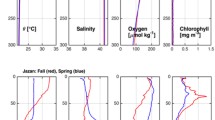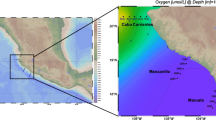Abstract
Increasing ocean temperatures and anthropogenic influences are contributing to marine oxygen minimum zone (OMZ) expansion, with consequent changes in nutrient and climate-active trace gas cycling. As a result, bacterial and archaeal mediation of biogeochemical transformations within marine OMZs has received attention. Less is known about the role of protists within OMZs, despite their potential importance to biogeochemical cycles. Here, we discuss responses of protist populations to water column oxygen deficiency in three ecosystems: the Saanich Inlet, a seasonally anoxic fjord on the coast of Vancouver Island, British Columbia, and two examples of permanently anoxic/sulfidic end-member water columns in Cariaco Basin (Venezuela) and Framvaren Fjord (Norway). Small subunit ribosomal RNA gene sequencing approaches partnered with multivariate statistical methods have been used to characterize microbial eukaryotes in each of these habitats. Common and unique patterns of community composition exist between the three locations reflecting different responses of components of the protistan community to specific geochemical parameters. Within Saanich Inlet, temporal fluctuations in rare populations of ciliates and flagellates may be significant to biogeochemical cycling particularly as a result of symbioses with, and predation on, other microbes.
Access this chapter
Tax calculation will be finalised at checkout
Purchases are for personal use only
Similar content being viewed by others
References
Arrigo KR (2005) Marine microorganisms and global nutrient cycles. Nature 437:349–355
Behnke A, Bunge J, Barger K, Breiner HW, Alla V, Stoeck T (2006) Microeukaryote community patterns along an O2/H2S gradient in a supersulfidic anoxic fjord (Framvaren, Norway). Appl Environ Microbiol 72:3626–3636
Behnke A, Barger KJ, Bunge J, Stoeck T (2010) Spatio-temporal variations in protistan communities along an O/HS gradient in the anoxic Framvaren Fjord (Norway). FEMS Microbiol Ecol 72:89–102
Bernhard JM, Buck KR, Farmer MA, Bowser SS (2000) The Santa Barbara Basin is a symbiosis oasis. Nature 403:77–80
Canfield DE, Stewart FJ, Thamdrup B, De Brabandere L, Dalsgaard T, DeLong EF, Revsbech NP, Ulloa O (2010) A cryptic sulfur cycle in oxygen-minimum-zone waters off the Chilean coast. Science 330:1375–1378
Diaz RJ, Rosenberg R (2008) Spreading dead zones and consequences for marine ecosystems. Science 321:926–929
Diaz RJ, Rosenberg R, Rabalais NN, Levin LA (2009) Dead zone dilemma. Mar Pollut Bull 58:1767–1768
Edgcomb V, Breglia SA, Yubuki N, Beaudoin D, Patterson DJ, Leander BS, Bernhard JM (2010) Identity of epibiotic bacteria on symbiontid euglenozoans in O2-depleted marine sediments: evidence for symbiont and host co-evolution. ISME J 5:231–243
Edgcomb V, Orsi W, Bunge J, Jeon S, Christen R, Leslin C, Holder M, Taylor GT, Suarez P, Varela R, Epstein S (2011a) Protistan microbial observatory in the Cariaco Basin, Caribbean. I. Pyrosequencing vs Sanger insights into species richness. ISME J 5:1344–1356
Edgcomb V, Orsi W, Taylor GT, Vdacny P, Taylor C, Suarez P, Epstein S (2011b) Accessing marine protists from the anoxic Cariaco Basin. ISME J 5:1237–1241
Edgcomb V, Leadbetter ER, Bourland W, Beaudoin D, Bernhard JM (2011c) Structured multiple endosymbiosis of bacteria and archaea in a ciliate from marine sulfidic sediments: a survival mechanism in low oxygen, sulfidic sediments? Front Microbiol 2:55
Embley TM, Finlay BJ (1993) Systematic and morphological diversity of endosymbiotic methanogens in anaerobic ciliates. Antonie van Leeuwenhoek 64:261–271
Fenchel T, Finlay BJ (1995) Ecology and evolution in anoxic worlds. Oxford University Press, Oxford
Fuhrman JA, Steele JA, Hewson I, Schwalbach MS, Brown MV, Green JL, Brown JH (2008) A latitudinal diversity gradient in planktonic marine bacteria. Proc Natl Acad Sci U S A 105:7774–7778
Lam P, Kuypers MM (2010) Microbial nitrogen cycling processes in oxygen minimum zones. Ann Rev Mar Sci 3:317–345
Lavik G, Stuhrmann T, Bruchert V, van der Plas A, Mohrholz V, Lam P, Mussmann M, Fuchs BM, Amann R, Lass U, Kuypers MM (2009) Detoxification of sulphidic African shelf waters by blooming chemolithotrophs. Nature 457:581–584
Li XN, Taylor GT, Astor Y, Scranton MI (2008) Sulfur speciation in the Cariaco Basin with reference to chemoautotrophic production. Mar Chem 112:53–64
Lin S, Zhang H, Hou Y, Miranda L, Bhattacharya D (2006) Development of a dinoflagellate-oriented PCR primer set leads to detection of picoplanktonic dinoflagellates from Long Island Sound. Appl Environ Microbiol 72:5626–5630
Lin XJ, Scranton MI, Chistoserdov A, Varela R, Taylor GT (2008) Spatiotemporal dynamics of bacterial populations in the anoxic Cariaco Basin. Limnol Oceanogr 53:37–51
Massana R, Terrado R, Forn I, Lovejoy C, Pedrós-Alió C (2006) Distribution and abundance of uncultured heterotrophic flagellates in the world oceans. Environ Microbiol 8:1515–1522
Naqvi SWA, Bange HW, Farıas L, Monteiro PMS, Scranton MI, Zhang J (2010) Marine hypoxia/anoxia as a source of CH4 and N2O. Biogeosciences 7:2159–2190
Orsi W, Edgcomb V, Jeon S, Leslin C, Bunge J, Taylor GT, Varela R, Epstein S (2011) Protistan microbial observatory in the Cariaco Basin, Caribbean. II. Habitat specialization. ISME J 5:1357–1373
Orsi W, Song YC, Hallam S, Edgcomb V (2012a) Effect of oxygen minimum zone formation on communities of marine protists. ISME J 6(8):1586–1601
Orsi W, Edgcomb V, Faria J, Foissner W, Fowle WH, Hohmann T, Suarez P, Taylor C, Taylor GT, Vdacny P, Epstein SS (2012b) Class Cariacotrichea, a novel ciliate taxon from the anoxic Cariaco Basin, Venezuela. Int J Syst Evol Microbiol 62:1425–1433
Pedrós-Alió C (2007) Ecology. Dipping into the rare biosphere. Science 315:192–193
Rutherford S, D’Hondt S, Prell W (1999) Environmental controls on the geographic distribution of zooplankton diversity. Nature 400:749–753
Schloss PD (2009) A high-throughput DNA sequence aligner for microbial ecology studies. PLoS One 4:e8230
Schubert C (1982) Origin of Cariaco Basin, southern Caribbean Sea. Mar Geol 47:345–360
Sherr EB, Sherr BF (2002) Significance of predation by protists in aquatic microbial food webs. Antonie van Leeuwenhoek 81:293–308
Stoeck T, Behnke A, Christen R, Amaral-Zettler L, Rodriguez-Mora MJ, Chistoserdov A, Orsi W, Edgcomb VP (2009) Massively parallel tag sequencing reveals the complexity of anaerobic marine protistan communities. BMC Biol 7:72
Stoeck T, Bass D, Nebel M, Christen R, Jones MD, Breiner HW, Richards TA (2010) Multiple marker parallel tag environmental DNA sequencing reveals a highly complex eukaryotic community in marine anoxic water. Mol Ecol 19:21–31
Taylor GT, Scranton MI, Iabichella M, Ho TY, Thunell RC, Muller-Karger F, Varela R (2001) Chemoautotrophy in the redox transition zone of the Cariaco Basin: a significant midwater source of organic carbon production. Limnol Oceanogr 46:148–163
Teske A (2010) Oceans. Cryptic links in the ocean. Science 330:1326–1327
van Hoek AH, van Alen TA, Sprakel VS, Leunissen JA, Brigge T, Vogels GD, Hackstein JH (2000) Multiple acquisition of methanogenic archaeal symbionts by anaerobic ciliates. Mol Biol Evol 17:251–258
Walsh DA, Zaikova E, Howes CG, Song YC, Wright JJ, Tringe SG, Tortell PD, Hallam SJ (2009) Metagenome of a versatile chemolithoautotroph from expanding oceanic dead zones. Science 326:578–582
Yubuki N, Edgcomb VP, Bernhard JM, Leander BS (2009) Ultrastructure and molecular phylogeny of Calkinsia aureus: cellular identity of a novel clade of deep-sea euglenozoans with epibiotic bacteria. BMC Microbiol 9:16
Zaikova E, Walsh DA, Stilwell CP, Mohn WW, Tortell PD, Hallam SJ (2010) Microbial community dynamics in a seasonally anoxic fjord: Saanich Inlet, British Columbia. Environ Microbiol 12:172–191
Zehnder AJB, Stumm W (1988) Geochemistry and biogeochemistry of anaerobic habitats. In: Zehnder AJB (ed) Biology of anaerobic microorganisms. Wiley, New York
Zuendorf A, Bunge J, Behnke A, Barger KJ, Stoeck T (2006) Diversity estimates of microeukaryotes below the chemocline of the anoxic Mariager Fjord, Denmark. FEMS Microbiol Ecol 58:476–479
Acknowledgments
This work was performed under the auspices of the Center for Dark Energy Biosphere Investigations and NSF MCB-0348407 to VE.
Author information
Authors and Affiliations
Corresponding author
Editor information
Editors and Affiliations
Rights and permissions
Copyright information
© 2013 Springer Science+Business Media Dordrecht
About this chapter
Cite this chapter
Orsi, W.D., Edgcomb, V.P. (2013). Microbial Eukaryotes in Marine Oxygen Minimum Zones. In: Seckbach, J., Oren, A., Stan-Lotter, H. (eds) Polyextremophiles. Cellular Origin, Life in Extreme Habitats and Astrobiology, vol 27. Springer, Dordrecht. https://doi.org/10.1007/978-94-007-6488-0_21
Download citation
DOI: https://doi.org/10.1007/978-94-007-6488-0_21
Published:
Publisher Name: Springer, Dordrecht
Print ISBN: 978-94-007-6487-3
Online ISBN: 978-94-007-6488-0
eBook Packages: Biomedical and Life SciencesBiomedical and Life Sciences (R0)




